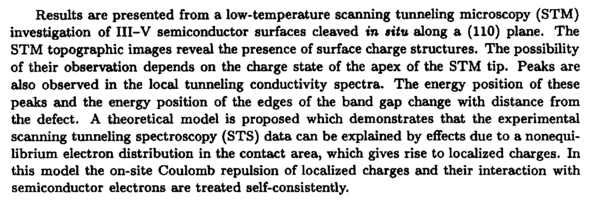The effects of non-equilibrium charge distribution in scanning tunneling spectroscopy of semiconductors
Arseyev P.I., Maslova N.S., Savinov S.V.
ID: 07.79.-v, 61.16.-d
Results are presented from a low-temperature scanning tunneling microscopy (STM) investigation of III-V semiconductor surfaces cleaved in situ along a (110) plane. The STM topographic images reveal the presence of surface charge structures. The possibility of their observation depends on the charge state of the apex of the STM tip. Peaks are also observed in the local tunneling conductivity spectra. The energy position of these peaks and the energy position of the edges of the band gap change with distance from the defect. A theoretical model is proposed which demonstrates that the experimental scanning tunneling spectroscopy (STS) data can be explained by effects due to a nonequi-librium electron distribution in the contact area, which gives rise to localized charges. In this model the on-site Coulomb repulsion of localized charges and their interaction with semiconductor electrons are treated self-consistently.


 Home
Home